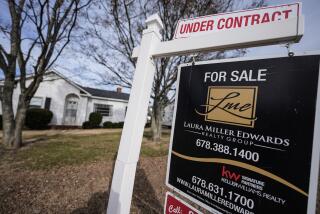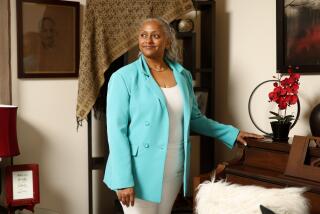Bringing Home the Deal : Real Estate Agent Competes for Sales in Market Slump
- Share via
Bill Baur, a real estate agent at the Woodland Hills office of Coldwell Banker, recently dropped by a house that’s for sale. It wasn’t the first time he’d seen the house, because it’s been on the market for more than a year.
About five months ago, the Woodland Hills house almost sold for $395,500, but it fell out of escrow. The agent who originally represented the sellers left the real estate business. Now, with the real estate market in a headlong slump, the same house is up for sale again at $339,950, represented by another agent.
The new agent was hosting an open house, complete with a catered Chinese lunch, and was trying to drum up renewed interest in the property among other agents who might represent potential buyers. Even though the house is in a quiet neighborhood and boasts a pool and spa, French doors, large gourmet kitchen and raised beam ceilings, Baur said it’s still going to be a tough sell--even at the reduced price.
Welcome to the San Fernando Valley real estate market, which was booming as recently as early 1989. But in the past year or so, the number of houses sold has plummeted and prices continue to fall. On average it now takes several months for a house to sell, but it took less than a month when the market was hot. And buyers have grown scarce.
In July, the latest month for which the San Fernando Valley Board of Realtors has statistics available, a record 13,973 houses were listed for sale in the Valley, 35% more than the previous July. The pace of sales was 33% slower than a year earlier, and the average resale price of a single-family house fell 5% from June to $291,800.
Baur has seen his numbers fall as well. So far this year, his commissions are down about 30% from last year, which was his best year since he started selling real estate in 1985. He grossed “just under six figures” last year, he said, although he declines to give precise numbers.
Baur still maintains five to six house listings at a time--the same as last year. But the listings are taking much longer to sell and he’s spending more money promoting them, including paying for his own catered open houses. Many frustrated would-be sellers are taking their houses off the market after finding they can’t get the prices they want.
Baur is also working with a couple of potential buyers, but the buyers in today’s market seem far pickier and more willing to wait, he said. Even when he does close a deal, Baur’s commissions are smaller because the prices are lower.
(A seller usually pays a commission of 6% of the sales price, with 3% going to the listing office and 3% going to the brokerage representing the buyer. An agent gets 50% to 100% of the commission his office receives, although the typical cut is about 60%.)
Like most agents, Baur blames the slowdown largely on the tremendous run-up in prices in the mid- to late 1980s, when houses commonly appreciated 20% to 30% a year. Now, many potential buyers are priced out of the market, and widespread fears of a recession have combined to put a brake on the housing market.
Faced with a new market reality, many agents are rethinking their strategies.
Some have gimmicks. One calls himself the “condo king.” Some specialize in selling only million-dollar houses. Others try to lure agents and the buyers they represent with lavish parties, lottery tickets, free vacations and cash bonuses.
But Baur is a technician. He wants to be known as the guy who knows his territory, the Carlton Terrace area of Woodland Hills, like the back of his hand. He says his painstaking, methodical approach will be the key to his staying power through a dismal housing market.
Baur, a 55-year-old former chemical engineer with an MBA degree, works 12-hour days, keeps voluminous records and data on the local real estate market, and hand-delivers a homemade, bimonthly newsletter to all 1,150 houses in Carlton Terrace. It takes Baur three days to deliver that newsletter, but he figures he cultivates contacts that one day may pay off in listings or sales.
“I believe this business is statistical,” he said. “If you turn over enough rocks, you might find something.”
Taking just enough time to eat breakfast and do a crossword puzzle with his wife of 33 years, Baur is at work by 8:30 a.m. each weekday. He almost always works weekends and can often be found sitting at his desk past 9 on weeknights, typing letters, going over documents, compiling statistics and working on promotional materials.
Baur keeps a notebook that is alphabetically organized by street and which contains one page for each of the 50 houses for sale in Carlton Terrace, an area bounded by Pierce College on the north, the Ventura Freeway on the south, Winnetka Avenue on the east and De Soto Avenue on the west.
In the notebook, Baur keeps information such as how long houses have been on the market, weekly price updates and a color picture of each property. House sales in Carlton Terrace have fallen at least 30% in the past year, mirroring the decline in the rest of the Valley, Baur said.
Baur has used other agents’ tricks of the trade. For the past several months, agents have been banding together to host “progressive lunches,” a practice that was all but abandoned when sales were booming in late 1980s. During the day, an agent might visit a dozen houses in one area, feasting on Brie and crackers, fresh fruit, deli sandwiches and hot fudge sundaes along the way.
The idea is to get other agents who may have prospective buyers to see the properties. A few weeks ago, for example, Baur set up a progressive lunch with other agents representing townhouses in the same complex where he has a property listed.
Baur lugged cartons of vanilla ice cream, bottles of root beer and cans of whipped cream to the townhouse and made root beer floats. The floats, which Baur paid for, were a big hit. Each of the five townhouses for sale was visited by 15 to 20 agents, compared to the three or four agents who might have shown up otherwise.
Nonetheless, all five townhouses remain unsold.
Baur also encourages sellers who can afford it to offer buyers help with financing. He also prods them to keep their houses in tip-top condition, with new paint and carpeting, and frequently holds open houses for prospective buyers.
But Baur says the overriding factor in today’s market is the hardest one for sellers to swallow: price.
“The value of a $300,000 house last year is now less than $300,000. I don’t think any agent will deny that fact,” he said.
But buyers do. Baur, for example, took a listing on a house in April and after analyzing the competition, suggested an asking price of $319,500 to $329,500. But the owner insisted on asking for $339,000.
A few months later, the house hadn’t sold and the owner lowered the price to $329,500. But by then, Baur said, the market had further deteriorated and even that price seemed high. The house is off the market now.
Baur urges his clients to lower their prices to get their houses sold now because he believes the market will continue to soften for at least three months and as much as a year. After that, he predicts, prices will stabilize, but it will likely be even longer before they start appreciating again.
Despite the lower numbers this year, Baur isn’t starving. He still drives a BMW, lives in a West Hills house that he says is worth between $500,000 and $600,000, and owns an investment property and a time-share in Hawaii.
But things are tighter, he admitted. “You may not buy as much clothing, or you may not go out as often to eat. You rent more movies instead of going out,” he said.
With no end in sight to the market slump, Baur said he will just keep plugging away, working long hours, walking up and down the streets of Carlton Terrace delivering his newsletters, knocking on doors and trying to win clients with his storehouse of knowledge.
“If I could get back to a 40-hour week, that would be really nice,” Baur said.
But that won’t happen any time soon. He’s even thinking of boosting the frequency of his newsletter to once a month. “I just don’t think you can give up in this type of market,” he said.
More to Read
Inside the business of entertainment
The Wide Shot brings you news, analysis and insights on everything from streaming wars to production — and what it all means for the future.
You may occasionally receive promotional content from the Los Angeles Times.











